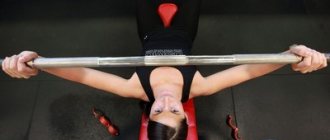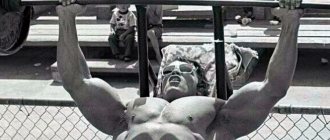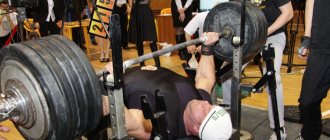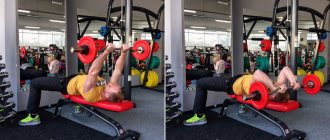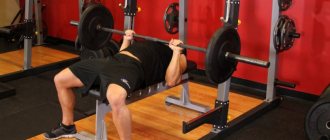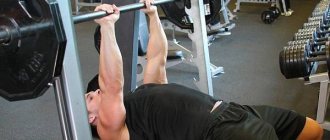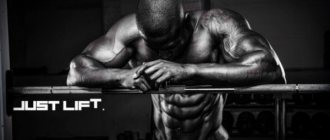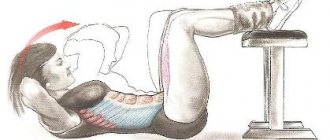Bench press strength training is an independent discipline for many athletes and the main indicator of the development of an athlete involved in bodybuilding and powerlifting. This is due to the fact that when performing heavy lifts of the barbell from a lying position, almost all the muscles of the body are trained.
With proper technique and regular exercise, both the upper and lower body will actively progress.
But still, most of the work will be done by the upper bundles of muscle fibers, which will make the athlete’s figure closer to ideal over time.
Training to improve the bench press is aimed at strengthening the areas that are actively involved in making the main effort.
When standard, basic approaches are no longer enough, you have to take on tightening your arms, back, legs, and rear deltoid muscles.
About powerlifting
Powerlifting is a powerlifting sport. The main goal of all powerlifters is to perform well in their weight class in competition. Competitive disciplines represent three basic strength exercises that are familiar to every trainee:
- barbell squat;
- bench press;
- deadlift.
The athlete's achievements are assessed by how much total weight he was able to lift when performing all three exercises. Unlike bodybuilding, in powerlifting the general appearance of the athlete and the definition of his muscles do not play a role at all, because the emphasis is on the development of strength indicators.
Boris Ivanovich Sheiko
Boris Sheiko rightfully received the title of Honored Coach of the USSR in powerlifting. “Powerlifting” is his training method for dischargers, which helps not only physically, but also mentally get in shape for upcoming competitions. In total, several books have been published where an experienced athlete and coach shares his own unique methods of planning exercises for athletes.
View gallery
Basic principles
It would seem that everything is simple with the training program, you just need to perform basic movements from powerlifting, gradually increasing the load. But once you remember the mechanics of movement when performing a deadlift or squat with a barbell, it becomes clear that the training program should be voluminous, because you need to strengthen and develop the strength of not only the main working muscles, but also the stabilizer muscles.
In general, the universal program consists of three basic movements for a specific muscle group. The goal is to perform many sets (4-6) with heavy weights, but only a few reps. Typically, during such a workout, each movement is repeated 5 to 8 times, depending on which muscle group is loaded.
But there is another option - to combine powerlifting training and exercises for general muscle development. Despite the fact that powerlifting and bodybuilding have different goals, many famous athletes train according to the principle of two disciplines at once in order to get not only a strong body, but also beautifully developed muscles.
The choice of training program depends on your goals and level of training. Beginners should start with a general basic program that includes more than just competitive disciplines. Powerlifters who want to grow and take on increasingly larger loads can limit themselves to a standard program of 3 exercises per day. True sports fans often combine powerlifting with bodybuilding, but you still have to decide which discipline is a priority.
Basic principles of training in powerlifting:
- adequate periodization of loads to avoid overtraining syndrome;
- performing bases with heavy weight;
- performing general exercises to strengthen all muscles;
- increased rest between approaches (compared to bodybuilding);
- emphasis on reps rather than reps;
- perfect execution technique.
A beginner will have to start by mastering the technique. If in bodybuilding there is still room for imperfect technique, for example, when working with your own weight, then in powerlifting, incorrect execution can cost not only your sports career, but also your health. A ready-made program for powerlifting still remains not universal, and to achieve really good results you need an individual approach and work with a qualified coach who knows the specifics of strength training in triathlon.
What All Straight Men Should Know
As a natural, you may have already tried many advanced programs and found them not very effective. This could happen for several reasons:
1. The main enemy of a straight person is too high a level of cortisol.
This is especially true if it is constantly elevated. Cortisol can significantly limit muscle growth: first, by increasing protein/muscle catabolism and decreasing protein synthesis, and second, by increasing myostatin production.
2. The volume of training load has the most significant effect on cortisol levels.
The main function of cortisol during physical activity is to mobilize stored energy. The more energy you expend during training, the more cortisol is produced. Therefore, the higher the load volume, the more cortisol. What conclusions can be drawn? Natural athletes cannot perform the same amount of work as athletes taking steroids and still expect optimal muscle growth.
3. Naturals cannot artificially increase the rate of protein synthesis.
They do not use anabolic drugs, therefore, the rate of protein synthesis depends almost entirely on training (and nutrition). Under normal conditions, the rate of protein synthesis in the trained muscle remains elevated for 24 hours after exercise. Then it decreases to normal levels.
For naturals who train a muscle only once a week, the growth of muscle mass will be quite slow - the rate of protein synthesis increases too rarely. Natural men will gain muscle growth faster if they train a muscle twice a week, and even faster if they can do it three times a week.
4. Training volume and frequency are inversely proportional.
The more often you train, the lower the volume of the load should be if you expect to increase muscle mass or strength.
The fundamental principles for naturals are:
- Train muscle groups more often—ideally 3 times a week—to increase your protein synthesis rate more often.
- Limit the amount of load - otherwise frequent training will become impossible.
- Since the number of working approaches will be small, give your best in each of them.
- Use different methods to stimulate muscle growth.
With all that said, let's move on to the program itself.
Where to start, or the importance of penetration
Getting to know powerlifting begins with climbing. This is the name given to the process of determining the maximum weight with which an athlete can work without harm to health. The algorithm for performing such a test to determine the workload is as follows.
1. Take a barbell and equip it with plates, according to your physical form. For some beginners this may be 30 kg, for others – 50 or more.
2. Perform one repetition of each of the three competition exercises.
3. Increase the load by 10 kg and repeat the execution.
4. Then add more pancakes and do the exercises again.
5. Increase the mass of the apparatus until the athlete is able to perform the exercise without someone else’s help. This is the maximum weight.
You can do all the exercises in one day. In general, you will have to devote an entire training session to driving. You need to rest between repetitions; rest can be three minutes or more, depending on your physical fitness.
Some beginners believe that penetration is optional. In fact, without knowing his personal repetition maximum (RM), a person will not be able to determine the working weight with which he will train effectively but safely.
No person can constantly train at maximum load, because such an approach inevitably leads to burnout or overtraining. To avoid this, but at the same time not stop progress, all training in powerlifting is divided into three types:
- light – with a weight of 50% of the personal maximum;
- moderate severity - about 60-70% PM;
- heavy - up to 90% PM.
The load alternates between weeks or from exercise to exercise, if the entire base is worked out during one session.
Positive feedback about the program
Like any book, Sheiko’s Powerlifting method has reader reviews. Fortunately, there are much more positive opinions from beginners and professional athletes than negative ones.
Many people note that this book helps to learn information about muscles that not only athletes should know for sure. This technique describes the training in detail, as well as additional material. In addition, each exercise is illustrated, and a person will be able to perform them correctly.
Another important fact is that the book describes the methods of world athletes. Many novice athletes strive to follow the example of those who have achieved considerable success in sports. Therefore, this section is not superfluous in the book. Sheiko's Powerlifting program attracts attention with excellent content that is understandable to everyone.
It should be noted that there are quite a large number of readers who became interested in powerlifting and started playing sports after reading it.
View gallery
Universal training plan
The following program is one of the most common; most amateur powerlifters practice it. However, every amateur sooner or later begins to strive to become professionals, so the training program must be revised over time.
Basic principles:
- weekly load change;
- 1-2 basic strength exercises per day;
- maximum 4 exercises per session.
The number of repetitions will depend on individual characteristics. On average, movements with heavy weights are performed 5-8 times, depending on experience and maximal max.
The first training week is structured as follows.
- Workout: bench press (5x5, 80% of RM), barbell squat (60% of weight, 5x5), French bench press (3-4x8).
- Workout: deadlift (80%, 5x5), hyperextension or crunches (3 sets maximum times), standing biceps curl (3x10).
- Workout: bench press (60%, 5x5), squat (80% RM, 5x5), bent-over dumbbell swings (3-4x10).
The load in auxiliary movements, such as biceps curls and French presses, is selected individually, according to sensations.
The plan for the second week is as follows.
- First session: squat (60%), bench press (70%), standing press (4-5x10).
- Second session: deadlift (75%), shrugs (5x15), close-grip bench press (5x10).
- Third lesson: squats (75%), calf raises in a machine or with dumbbells (3x20), barbell rows to the collarbones (3x10).
In these plans, the base (barbell squat, bench press and deadlift) is always performed in 5 sets of 5 repetitions. In brackets is the weight from the personal maximum that needs to be exercised on a certain day.
Third week:
- 1 – squat (85%), bench press (50%, 4x15);
- 2 – deadlift (75%), bent-over barbell row (3-4x10);
- 3 – squat (50%), bench press (75-80%), close-grip bench press (4x8-10).
In the third week, the number of exercises decreases, as the body needs to rest, reducing the load.
In addition, the third week program can be used by beginners who have just begun to master powerlifting. These exercises can be combined with work on machines and your own weight to develop general physical performance.
Alternative workout for the bench press[edit | edit code]
Workout 1
- Press (according to the diagram)
- Horizontal block pull (rowing) - 3x8-10
- Press up from racks 85-90% x 2-4 times in different workouts.
- Lying dumbbell fly - 3x8-10
Workout 2
- Press - (pyramid - only in the preparatory cycle - according to the scheme)
- Standing press - 5x3
Workout 3
- Press (according to the diagram)
- Traction on the block horizontally - 3x8-10
- Dips - 5x4-6
- Lying dumbbell fly - 3x8-10
Workout 4
- Press (different in different weeks, but light - 65% - 4x6, or 70% - 5x5, or 75% - 5x3.
- Biceps curl 3x6-8
- Standing press 5x4-5
Plan to Increase Bench Press
One of the most problematic disciplines in powerlifting is the bench press. This is due to the small size of the pectoral muscles and the relatively small initial burden. Deadlifts and squats use approximately the same muscles, so performance in these disciplines increases much faster. If you need to increase your bench press results in a short time, the following training plan is recommended. This program is designed for 2 months, the emphasis is on the development of the chest, triceps and biceps, the lower part of the body is lightly loaded. The plan is not suitable for beginners; it is designed for intermediate and advanced levels of training.
Monday Tuesday):
- Ab crunches;
- bench press;
- wide grip push-ups;
- butterfly pinch;
- pull-ups;
- standing biceps curls;
- extension and flexion of the wrists while sitting with weights.
The number of repetitions for all exercises is 3x10 times. In this program, the bench press is always performed 5x5, the weight is 80% of the maximum.
Second lesson (Wednesday or Thursday):
- raising your legs on a bench;
- seated press;
- swings with weights to the sides;
- broach with a bar;
- pull-ups;
- Bent-over dumbbell row;
- pulling the block to the chest.
Do everything again 3x10.
Third lesson:
- hyperextension;
- deadlift (80% of 1RM);
- bench press (close grip);
- dips;
- French bench press;
- squat (60% weight).
The number of repetitions of all movements except deadlifts and squats is 3x10. The triathlon base is performed 5x5.
An increase in strength when performing bench presses and growth of the pectoral muscles are noticeable already in the fourth week of such training.
Bench press
View gallery
This exercise is universal, as it is involved in two main groups. As a competitive exercise, it is performed exclusively on a horizontal bench. The barbell is clearly fixed in straightened arms and, at the judge’s command, it must be lowered to the chest, make a visible pause, and then press it onto straightened arms.
As a special preparatory exercise, the bench press can be performed both on a horizontal and on an inclined bench. It can also be done not only with your head up, but also on a reverse incline bench. In this group, dumbbells can replace the barbell.
Program for beginners
Quite often, young people who have never worked out in a gym before decide to start with powerlifting. The following plan is designed specifically for those who have no training experience or have been training for about 2-3 months in a bodybuilding program.
Primary requirements:
- lack of significant excess weight;
- healthy spine;
- classes in the gym (the plan includes work on the simulators).
Essentially, this is a standard plan aimed at building muscle mass, but with an emphasis on all-around strength disciplines. It is recommended to study according to this plan for 2-3 months, and then you can move on to the universal program for powerlifting described above.
Day one - emphasis on developing the lower body and pectoral muscles:
- twisting or hyperextension;
- barbell squat;
- bench press;
- lunges with a barbell or dumbbells;
- seated chest press;
- bending and extending legs in the simulator.
Since the class is designed for beginners who have never worked out in the gym before, passing is not required. Working weight is determined individually. Here you don’t need to strive to take the maximum at once, so you should perform squats and bench presses with weights that will allow you to perform 8-10 repetitions.
Second day – emphasis on arm muscles:
- leg raises on parallel bars;
- classic push-ups;
- pull-ups (reverse grip);
- French bench press;
- hammer curls;
- lying down pullover;
- flexion and extension of the wrists while sitting.
On the third day, the muscles of the shoulder girdle and back work:
- hyperextension;
- deadlift;
- standing barbell press from the chest;
- pulling the upper block behind the head;
- broach;
- pulling the block to the chest.
All exercises in the plan for beginners are performed in 3 sets of 10-15 times. The workload should be increased every week by 10% - this way you can achieve fairly rapid progress without overloading the body.
Questions and answers
I'll try to answer the most common questions:
Can I do this program if I can't train 6 times a week?
If you can train 4 or 5 times a week, then you can do this program. Just do all 6 workouts in order. The “training” week will be a little longer than the calendar week.
For those who can only train 3 times a week, this program is not the best option, since it is based on a high-frequency load.
Is this program suitable for drying?
I would like to first remind you that “cutting” means a calorie deficit, and therefore my answer is: “yes, but...”
To get the most benefit from a strength or mass program, you need to maintain a calorie surplus. This is especially important for straight men. On a maintenance calorie diet, you can also gain weight and strength, but the process will happen more slowly.
What about a calorie deficit? It is not ideal for the masses. Under certain circumstances, it is possible to gain some muscle on a small calorie deficit, but even in the best case, the potential for muscle tissue growth will be significantly limited by the lack of nutrients.
And for strength? Since strength depends not only on muscle mass, but also on the efficiency of the nervous system, it is somewhat easier to develop it on a calorie deficit. However, strength gains will be significantly slower than in a calorie surplus.
Why? Firstly, because you will not be able to gain as much muscle mass as you could gain. Less muscle mass means less strength growth potential.
Secondly, by cutting carbohydrates (this is how you usually achieve a calorie deficit), you reduce the amount of water in the muscles, and this negatively affects biomechanical levers. Dehydration or a decrease in the water-holding capacity of cells can negatively affect strength performance, even if muscle mass remains the same. This is why powerlifters “pour” before competitions.
Finally, by cutting calories, you can reduce the efficiency of the central nervous system because it functions primarily on glucose.
Therefore, I strongly recommend doing this program in a calorie surplus, albeit a small one.
However, if you still need to train while drying. And since at this time the body’s ability to recover and adapt to training loads decreases, no program will give you a significant increase in strength. Therefore, this program is as suitable for drying as any other.
Or maybe even better: thanks to the small volume of load, the likelihood of overtraining/underrecovery is reduced. So, yes, this program is suitable for cutting, but do not expect the results that you could get with a surplus.
Can I add cardio?
The answer will be the same as for the previous question: Yes, but...
Moderate cardio (aerobic exercise or short intervals) will not render the program useless. The key word is moderate. In other words, if you run 60-90 minutes every day, there's a good chance you won't make as much progress as if you just followed the program.
30 minutes of aerobic exercise or 12-15 minutes of interval training 2-3 times a week is no big deal. But try to understand that, as with calorie deficits, they can slow down your progress a little.
Can I add abs and/or calves exercises?
Can. For the press, I personally use a blitz strategy, which fits perfectly into the structure of this program.
For 3 weeks I train my abdominal muscles every day, for the next 3 weeks I don’t train at all. Then again I train for 3 weeks and don’t train for 3 weeks. I generally recommend doing a superset consisting of two exercises (one with weights, one without) for 3 sets.
Calf exercises can be done at the end of bench training 3 times a week. The mTOR activation method is most suitable for them. Do 2 warm-up sets first, then one mTOR failure set. These exercises can be done sitting, standing, or in a donkey machine.
Can I continue with this program after completing the 12-week cycle?
Yes. Simply retest your ultimate max on 6 “basic movements” to calculate the working weights for the next cycle. If you decide to start a new cycle, replace the assistance (with hypertrophy) and heavy assistance exercises. There is no need to change the basic movements.
There is another option: for 3-6 weeks, switch to the “Best Program for Natural” or “Best Program for Natural - 2”, and then return to the strength program.
Such training, subject to proper intensity, will add both mass and strength. It can change the way you think about training forever. If you're tired of wasting time on “traditional” programs, this program may be the solution you've been looking for.
Source: t-nation.com
Translation for Zozhnik: Alexey Vakin
Subscribe to our telegram channel, and may the force be with you
Before and after training
Powerlifting cannot be rushed, so you must approach the activity responsibly and thoroughly.
- Always start with a warm-up. Since powerlifting involves a large axial load on the spine, you should start with an impact load - running or fast walking. Then be sure to stretch your back and lower back, for example, by performing yoga warm-up movements or the “boat”. This is very important, since an insufficiently warmed body and an unprepared spine may not withstand work with heavy weights.
- The second important nuance is rest between approaches. Since powerlifting involves working almost to the limit of your capabilities, you can and should rest. If in bodybuilding the average rest lasts about two minutes, in triathlon it increases to five or more. In general, an athlete should rest as much as they need to recover their strength. You will often see a powerlifter in the gym performing three exercises within an hour and a half - this is completely normal.
- When training according to a plan that focuses on the base with heavy weights, it is recommended to enlist the support of a partner. This is especially important for beginners, because they cannot always correctly calculate their strength and assess their level of training.
- The squat and deadlift technique in powerlifting is somewhat different from what bodybuilders do. It can take a long time to describe the nuances, so the best solution would be to consult with a professional triathlete or work with a coach. However, for beginners the weight is light at first, so you can perform movements using the classical technique. As the load increases, each person begins to feel their body better and grasp the necessary nuances in performance.
- Cooling down is optional, but is one of the useful tools in shaping an athletic body. Nothing bad will happen if you don’t do it, but with a cool-down, the muscles recover faster. Everyone decides for themselves whether they need to stretch after a strength session, but experienced athletes still recommend spending an extra 20 minutes and doing a cool-down - the body will be grateful.
- An athletic belt and elastic knee braces when working with heavy weights are not a whim, but very useful additional equipment. Moreover, it is recommended to use a belt and knee bandages from the first steps in powerlifting. In addition to fixing the joints and lower back in the desired position, the protection reduces the risk of injury.
And lastly, there is no need to chase weights on the barbell; progress should occur smoothly and gradually. Regular exercise will definitely bring results.
Author's shortcomings
As mentioned above, Sheiko’s powerlifting training plan has virtually no negative reviews. For arresters, he presents a good manual with decent recommendations. The only thing that athletes note is too weak or too strong loads. But we should not forget that for each person the additional weight and number of repetitions must be calculated separately. Therefore, the author did not notice any particular shortcomings, and all the material presented in the program motivates athletes to new victories. In Sheiko’s book “Powerlifting,” absolutely anyone with desire and willpower can progress from beginner to master.
Power training phase.
The last phase of the cycle is the power training phase. This involves sets of 1-4 repetitions with intensity gradually increasing from 90% to approximately 107% of one-time maximum. During this phase, the athlete reaches peak strength levels for competition. The rest between sets should be even longer - 5-10 minutes: the muscles should be fully restored between sets with maximum intensity. After completing the cycle and competitions, if any, it is best to rest for 1-2 weeks, since high-intensity work with single repetitions greatly tires both the body and spirit. One to two weeks is enough to fully recover from the enormous stress incurred during the power training phase. This rest can be either active or passive.
Injury Prevention
This is how to bandage
Of course, if the execution technique is followed, the risk of injury is unlikely. Do not try to immediately lift too much weight on the barbell; do everything necessary correctly and on time. Protect your lower back by purchasing a weightlifting belt. To protect your knees, use special knee pads, and use bandages for your hands.
Most often, the main site of injury is the knees. Weightlifters largely suffer from chronic knee disease (knees hurt when squatting), this is a consequence of high loads on the body during approaches.
The shoulders also suffer quite often, and in powerlifting this is the second most common problem. The risk of displacement of the musculoskeletal system is quite high, watch out for this. To avoid stretch marks and pain, always start with a warm-up. Absolutely all professionals do exactly this. In addition, damage occurs due to improper technique of performing the method.
Also, many people neglect safety precautions and are sometimes too self-confident at the very beginning of their journey. Concentrate completely on the exercises and be attentive. And of course, do not go to the gym if you are feeling unwell or sick.
Today, there is a variety of sports equipment that reduces the likelihood of injury. Knowledge of biology and anatomy will help you understand how the body works. In order to protect yourself from injuries, reduce the intensity of approaches and exercises.
Always keep in mind that some injuries lead to an unfavorable outcome, namely disability, which will put an end to all your sports activities. Hands are always damaged during training with arbitrary loads and excessive stretching of the muscles.
Dmitry Golovinsky biography of Ukrainian powerlifter
Dmitry Golovinsky is a popular Ukrainian powerlifter, coach, record holder in Ukraine and the world. The athlete was able to bench press a barbell weighing 302.5 kg without using a bench shirt.
Dmitry was born in 1988 on June 29. Received a diploma from a higher state university. He started playing sports at the age of 14. At the age of 17, he began to be interested in powerlifting, especially the bench press. He is a simple, modest person, so he did not chase records, especially competing in competitions. I devoted more experience to the sport itself, but was in no hurry to participate in competitions.
This choice was made correctly, since Dmitry Golovinsky emerged as a strong athlete who devoted himself headlong to the bench press. Mentor Dmitry Kurochkin, who helps him draw up a training plan. The coach helped him become the world and Ukrainian champion in this movement.
Bench press – 302.5 kg
Squats 330 kg
The man does not hesitate to talk about steroids to beginners. Explains all the consequences of taking pharmacology.
Strength indicators:
- Squats – 270 kg (in the gym 330-340 kg in bandages);
- Bench press – 302.5 kg (Ukrainian record);
- Deadlift – 270 kg (in the gym 300-320).
Anthropometric data:
- Weight – 135 kg;
- Height – 185 cm;
- Bench press – 302.5 kg.
He does bench presses at every workout, but also performs other exercises from powerlifting. Also, standing barbell presses with heavy weights, different grips during the press. Uses additional exercises. When the week is intense, do paired workouts three times. In some ways this is similar to a weightlifting program. Reduces the volume and number of training sessions before competitions.
Dmitry's biceps record is 100 kg
To restore muscles, the total training load is not very large
Additional exercises focus on the triceps and pectoral muscles
He does not consume sports nutrition. Rarely buys Riboxin and vitamins. It’s not clear about pharmacology, but there was talk that the athlete uses growth hormone, inulin and other steroids.
This is interesting: Pilates for beginners - Pilates basics, scientific research and training scheme
Sports nutrition to increase strength
There are no specialized, magical supplements to increase strength. Except, of course, anabolic steroids (for example, Anadrol), which, if used incorrectly, can simply destroy health and the athlete will end his career.
Therefore, if you are not a professional athlete who is not threatened by the sport of the highest achievements, where people earn a lot of money and find sponsors, forget about steroids, concentrate your attention on sports nutrition, which, if used correctly, can significantly increase the strength of an athlete
It is important to understand that the supplement itself is useless, it is necessary to use it in combination with strength exercises, then the muscles will respond to the load, increasing strength
It is important to understand that the supplement itself is useless, it is necessary to use it in combination with strength exercises, then the muscles will respond to the load, increasing strength
Creatine
The most important supplement for increasing strength is creatine (a nitrogen-containing carboxylic acid), which plays a huge role in energy metabolism when it comes to anaerobic training.
Accumulating mainly in the muscles, creatine accumulates energy, firing high levels of explosive power in competitions or training.
If there is a lack of creatine in the body, the athlete's strength will inevitably decline. Therefore, if you regularly work out in the gym and are looking to increase strength, creatine-containing supplements should be #1 in your sports nutrition bag.
Taking creatine monohydrate

